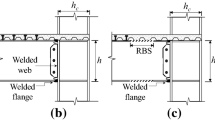Abstract
A new self-centering steel post-tensioned connection using web hourglass shape pins (WHPs) has been recently developed and experimentally validated. The connection isolates inelastic deformations in WHPs, avoids damage in other connection parts as well as in beams and columns, and eliminates residual drifts. WHPs do not interfere with the composite slab and can be very easily replaced without bolting or welding, and so, the connection enables non-disruptive repair and rapid return to building occupancy in the aftermath of a strong earthquake. This paper presents a simplified nonlinear model for the connection and the associated beams and columns that consists of nonlinear beam-column elements, and hysteretic and contact zero-length spring elements appropriately placed in the beam-column interface. The model was calibrated against experimental results and found to accurately simulate the connection behaviour. A prototype building was selected and designed as a conventional steel moment-resisting frame (MRF) according to Eurocode 8 or as a self-centering steel MRF (SC-MRF) using the connection with WHPs. Seismic analyses results show that the conventional MRF and the SC-MRF have comparable peak storey drifts, and highlight the inherent potential of the SC-MRF to eliminate damage in beams and residual drifts. The paper also shows that repair of damage in the conventional MRF will be costly and disruptive after the design basis earthquake, and, not financially viable after the maximum considered earthquake due to large residual drifts.

















Similar content being viewed by others
References
AISC (2005) Seismic provisions for structural steel buildings. Chicago, IL
Charney FA, Downs WM (2004) Connections in steel structures V. ESSC/AISC Workshop. Amsterdam, June 3–4
Chou CC, Lai YJ (2009) Post-tensioned self-centering moment connections with beam bottom flange energy dissipators. J Constr Steel Res 65(10–11):1931–1941
Chou CC, Chen JH, Chen YC, Tsai KC (2006) Evaluating performance of post-tensioned steel connections with strands and reduced flange plates. Earthq Eng Struct Dyn 35(9):1167–1185
Chou CC, Tsai KC, Yang WC (2009) Self-centering steel connections with steel bars and a discontinuous composite slab. Earthq Eng Struct Dyn 38:403–422
Christopoulos C, Filiatrault A, Uang CM, Folz B (2002) Posttensioned energy dissipating connections for moment-resisting steel frames. J Struct Eng 128(9):1111–1120
EC1(2009) Eurocode 1: actions on structures-Part 1-1: general actions-densities, self-weight and imposed loads
EC8 (2009) Eurocode 8: design of structures for earthquake resistance-Part 1: general rules, seismic actions and rules for buildings
EC3 (2010) Eurocode 3: design of steel structures- Part 1-1: general rules and rules for buildings
Garlock M, Ricles JM, Sause R (2005) Experimental studies of full-scale posttensioned steel connections. J Struct Eng 131(3):438–448
Garlock M, Sause R, Ricles JM (2007) Behavior and design of posttensioned steel frame systems. J Struct Eng 133(3):389–399
Karavasilis TL, Seo CY (2011) Seismic structural and non-structural performance evaluation of highly-damped self-centering and conventional systems. Eng Struct 33(8):2248–2258
Karavasilis TL, Ricles JM, Sause R, Chen C (2011) Experimental evaluation of the seismic performance of steel MRFs with compressed elastomer dampers using large-scale real-time hybrid simulation. Eng Struct 33(6):1859–1869
Karavasilis TL, Kerawala S, Hale E (2012) Model for hysteretic behaviour of steel energy dissipation devices and evaluation of a minimal-damage seismic design approach for steel frames. J Constr Steel Res 70: 358–367
Kim HJ, Christopoulos C (2008a) Friction damped posttensioned self-centering steel moment-resisting frames. J Struct Eng 134(11):1768–1779
Kim HJ, Christopoulos C (2008b) Seismic design procedure and seismic response of post-tensioned self-centering steel frames. Earthq Eng Struct Dyn 38(3):355–376
Kobori T, Miura Y, Fukuzawa E, Yamada T, Arita T, Takenaka Y, Miyagawa N, Tanaka N, Fukumoto T (1992) Development and application of hysteresis steel dampers. Earthquake engineering, tenth world conference, Balkema, Rotterdam
Mazzoni S, McKenna F, Scott M, Fenves G (2006) Open system for earthquake engineering simulation (OpenSees). User command language manual, Pacific Earthquake Engineering Research Center, University of California, Berkeley
Mc Cormick J, Aburano H, Ikenaga M, Nakashima M (2008) Permissible residual deformation levels for building structures considering both safety and human elements. In: 14th WCEE, Beijing, China
Ricles J, Sause R, Garlock M, Zhao C (2001) Posttensioned seismic-resistant connections for steel frames. J Struct Eng 127(2):113–121
Ricles J, Sause R, Peng SW, Lu LW (2002) Experimental evaluation of earthquake resistant posttensioned steel connections. J Struct Eng 128(7):850–859
Rojas P, Ricles JM, Sause R (2004) Seismic performance of post-tensioned steel moment resisting frames with friction devices. J Struct Eng 131(4):529–540
Somerville P (1997) Development of ground motion time histories for phase 2 of the FEMA/SAC steel project, Report No. SAC/DB-97/04, Sacramento, CA
Tsai KC, Chou CC, Lin CL, Chen PC, Jhang SJ (2008) Seismic self-centering steel beam-to-column moment connections using bolted friction devices. Earthq Eng Struct Dyn 37:627–645
Vasdravellis G, Karavasilis TL, Uy B (2012) Large-scale experimental validation of steel post-tensioned connections with web hourglass pins. J Struct Eng (in press)
Vasdravellis G, Karavasilis TL, Uy B (2013) Finite element models and cyclic behaviour of self-centering steel post-tensioned connections with web hourglass pins. Eng Struct (in press)
Whittle J, Williams MS, Karavasilis TL, Blakeborough T (2012) A comparison of viscous damper placement methods for improving seismic building design. J Earthq Eng 16:540–560
Wolski M, Ricles JM, Sause R (2009) Experimental study of a self-centering beam-column connection with bottom flange friction device. J Struct Eng 135(5):479–488
Author information
Authors and Affiliations
Corresponding author
Rights and permissions
About this article
Cite this article
Dimopoulos, A.I., Karavasilis, T.L., Vasdravellis, G. et al. Seismic design, modelling and assessment of self-centering steel frames using post-tensioned connections with web hourglass shape pins. Bull Earthquake Eng 11, 1797–1816 (2013). https://doi.org/10.1007/s10518-013-9437-4
Received:
Accepted:
Published:
Issue Date:
DOI: https://doi.org/10.1007/s10518-013-9437-4




